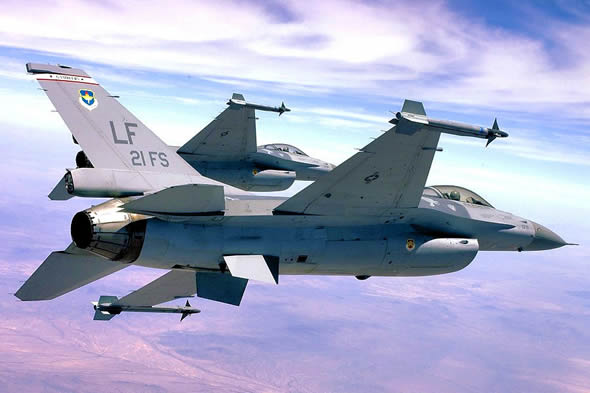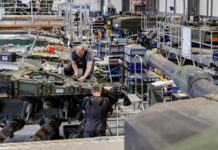
After dragging Taiwan’s request for 66 new F-16C/Ds for five years, the U.S. administration seems to agree to upgrade the island state’s 145 F-16A/B fighters for a hefty budget of up to US$5.3 Billion, reflecting an average cost of more than $36 million per aircraft. The package includes the integration of an unspecified AESA radar, helmet mounted cueing system (JHMCS) supporting AIM-9X air/air missiles and advanced electronic warfare and self-protection systems. Targeting pods and precision guided munitions will also enhance the fighters’ air/ground capability.

The upgrade program includes 176 sets of Active Electronically Scanned Array (AESA) radars; Embedded Global Positioning System Inertial Navigation Systems (GPS_INS) and 128 Joint Helmet Mounted Cueing Systems (JHMCS) and Night Vision Goggles sets expanding the aircraft fighting envelope using all-aspect air/air and precision targeted air/ground weaponry. The suppliers of the AESA radar have yet to be announced, but previous reports named Northrop Grumman (SABR) and Raytheon (RACR) as possible suppliers.
For the air/air mission the U.S. is ready to deliver 140 AIM-9X Sidewinder missiles and support systems. Upgrades to the APX-113 Advanced Identification Friend or Foe (IFF) combined interrogator transponders and HAVE GLASS II which includes the ‘golden canopy’ derived from the F-22 Raptor and other treatments for radar and thermal signature reduction.
With the new upgrades, the U.S. offers a significant weapons package for the upgraded Viper, including GPS guided bombs (GBU-31v1 and GBU-38 JDAM), Laser JDAM (GBU-56) or GPS Enhanced Laser Guided Weapons (GBU-10 Enhanced Paveway II) and Enhanced Paveway III 200 pound laser guided bombs. Also included are CBU-105 sensor fused weapons.
Part of the upgrade will also include the modernization of the aircraft electronic warfare and self protection systems, to include the ALQ-213 Electronic Warfare Management systems. The package also includes upgrades to the islands’ 82 existing ALQ-184 Electronic countermeasures (ECM) pods, to incorporate Digital Radio Frequency Memory (DRFM) technology. Alternatively, the Pentagon offers new ECM pods (either AN/ALQ-211(V)9 Airborne Integrated Defensive Electronic Warfare Suites (AIDEWS) or AN/ALQ-131 pods, both delivered with DFRM).
Supporting precision strike and close-cooperation with ground forces, the Pentagon suggests equipping the Taiwanese Vipers will be equipped are 86 tactical data link terminals, deliver 26 advanced targeting pods – both the AN/AAQ-33 SNIPER from Lockheed Martin or Northrop Grumman’s AN/AAQ-28 LITENING. In addition, Taiwan’s existing 28 Sharpshooter electro-optical infrared targeting pods will be upgraded. The new supply of targeting systems will double the number of Taiwan’s air force fighters carrying advanced targeting systems for use with precision guided weapons.
Through the modernization process the aircraft could also be fitted with improved engine, replacing the original F100-PW-220 powerplant with the latest model F100-PW-229 engines. Other upgrades could include the replacement of Modular Mission Computers, cockpit multifunction displays, communication equipment, Joint Mission Planning Systems.
While the formal request for the upgrade of Taiwan’s F-16A/B fighters has not been issued yet, Taipei is requesting U.S. approval for a pilot training program worth about half a billion US$, to include continued training of Taiwan’s fighter pilots at the Luke Air Force Base in Arizona, in addition to associated equipment, parts, training and logistical support. Taipei has also requested approval for acquisition of US$52 million worth of spare parts to support its U.S. built F-16A/B, F-5E/F and C-130H aircraft, and U.S. manufactured spares supporting Taiwan’s Indigenous Defense Fighter (IDF) aircraft. (Sept 21, 2011)
As expected, China expressed its concern over the U.S. decision. “China strongly urges the United States to be fully aware of the high sensitivity and serious harm of the issue, seriously treat the solemn stance of China, honor its commitment and immediately cancel the wrong decision,” vice foreign minister Zhang Zhijun told Locke, according to the official Xinhua news agency. China snapped military exchanges with the United States in January 2010 after President Barack Obama’s administration approved an earlier $6.4 billion package that included helicopters and Patriot missiles, although cooperation resumed within months.
















